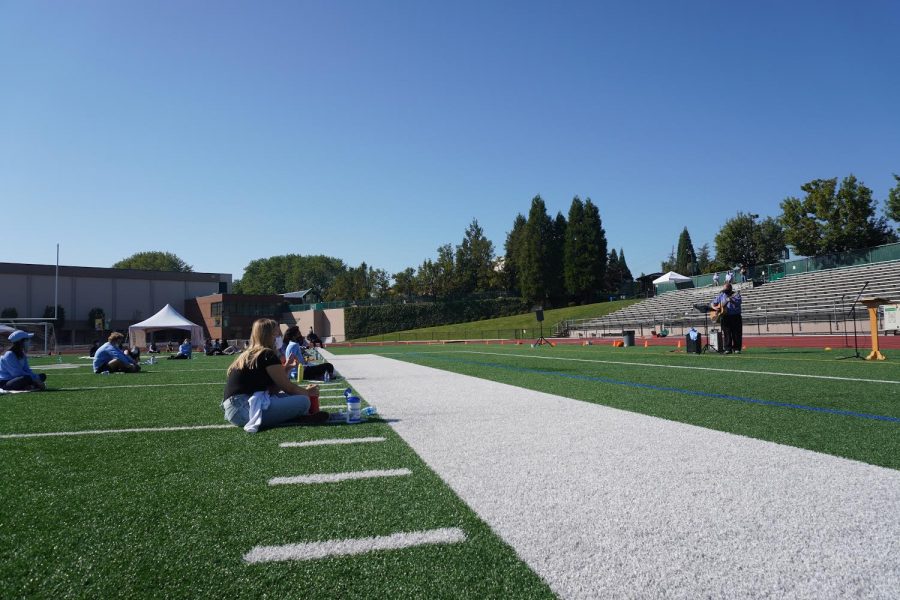Are Students Wearing Masks and Social Distancing When Socializing?
While the pandemic steadily continues, student views of precautionary measures regarding the Covid-19 Virus have potentially altered.
During the month of April, 3 months after the first announced case of Covid-19 in the United States in January, the CDC officially recommended the use of masks in order to prevent the spread of the virus (Vox News). By the month of July, masks were made mandatory to wear in public in multiple states throughout the US (CNet).
Throughout the first few months of quarantine, feelings of unease and fear spread, as the US still had limited information regarding the virus.
“In the beginning I was really scared. I would check the cases [and] I wouldn’t go outside…Now, it’s a little more relaxed,” senior Afua Pinamang-Boampong said. “I’ll go to the grocery store with my mom, I’ll hang out with friends as long as I have the right gear on and social distance; I’m not that worried.”
Currently, regulations regarding precautionary measures have been more lenient, with the use of masks simply recommended by the CDC when in public (CDC). While more lenient, regulations are still implemented in order to insure safety, causing students to think of more creative ways to stay connected.
“I’ve facetimed a thousand times more than I ever have in my entire life,” Pinamang-Boampong said. “I’ve gone on picnics with friends, and we sit on different blankets. I’ve become more innovative in the way I hang out with people. So finding things we can do distanced and being safe.”
With quarantine continuing to be the safest precautionary measure, the lack of traditional socializing may be linked to students’ deteriorating mental health, as connections could be severed between friends.
“I would think most students are like most of the population. They are in favor of masks and social distancing until it becomes inconvenient for them,” health teacher Mr. Skipper said. “As students feel more isolated, I feel they are more likely to break the protocols. I know it has been a struggle in my own house to balance being socially responsible and the mental health of my kids. I would assume this is a struggle among lots of families.”
A survey taken on the Jesuit News website displayed that 3 out of 5 students sometimes wear masks outside, while 2 out of 5 students always wear masks outside (jesuitnews.com).
“I worry not just about students, but everyone’s view about the protocols,” Skipper said. “The longer this goes on, the less fear we seem to have. With less fear, people will be less likely to follow the protocol.”
The frequency of precautionary measures taken by students varies, as some students have begun to hang out with small, close-knit groups of select friends outside of their family.
“It’s changed because my parents [now] allow me to have ‘bubbles’ with friends,” junior Kurt Woodruff said. “So I have a selected group of no more than 10 people that I hang out with so we are still constricted, so it’s kind of sad because I’m not going to parties or hanging out with random people.”
Although unable to hang out with many people, students have found that restrictions have revealed true friendships and the value of making an effort to stay connected to one another.
“Friendships feel deeper in a way because you actually have to reach out to people, and you can see who are your real friends and who’s maybe not…There’s so many friends at school that you say hi to but you wouldn’t hang out outside of school,” Woodruff said. “I kind of missed seeing them, but at the same time all of the people who have reached out to me, we now hang out and FaceTime and that means a lot because I get to know them better.”

Scout Jacobs is a managing editor for the Jesuit Chronicles at Jesuit High School. As a senior in high school, this is her third year doing Journalism, and she loves to write. Journalism has been a primary passion of hers throughout highschool, and she hopes to continue this passion through college. Outside of school and writing, Scout enjoys reading, hanging out with friends, and listening to music. She is on the swim team at Jesuit, and has been swimming since she was a freshman. Born and raised in Portland, OR, Scout has an older brother who graduated Jesuit last year, who is now attending Seattle University. In her free time, she is usually watching a movie or spending time with her family at home or at fun destinations around Portland. Her favorite subject in school is English, and she has been taking French throughout her high school career in hopes of becoming fluent in the language. She loves the outdoors, and her favorite activity to do with friends is to go on a hike or go swimming. During the weekends and long breaks, Scout usually visits her family in Seattle, where most of her extended family lives. Both of her parents are architects, and she loves hearing about their work and the creativity they use to feel passionate about their work.



